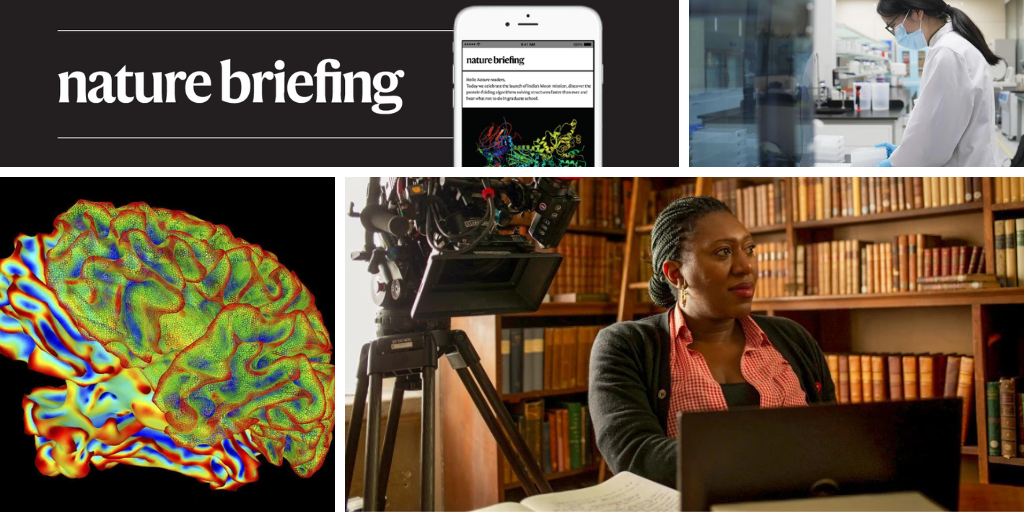You have full access to this article via your institution.
Hello Nature readers, would you like to get this Briefing in your inbox free every day? Sign up here.
Functional magnetic resonance imaging is a non-invasive way to explore brain activity.Credit: National Institute of Mental Health/National Institutes of Health/SPL
A technique called ‘mind captioning’ generates descriptive sentences of what a person is seeing or picturing in their mind using scans of their brain activity. It is based on artificial intelligence models trained on the text captions of thousands of videos, and brain scans of people watching them. The technique could help those with language difficulties to communicate better, says computational neuroscientist Alex Huth. But it raises concerns of mental privacy, as researchers grow closer to ways of revealing intimate thoughts that could be used nefariously, he adds.
Reference: Science Advances paper
Chinese scientists now lead more than half of all joint research projects with the United Kingdom, and are set to lead an equal number of those with Europe and the United States in the next few years. Chinese leaders are becoming particularly prominent in fields such as physics and engineering, but the country needs to strengthen its leadership capabilities in disruptive basic research, “as Nobel-level original breakthroughs remain rare”, says physicist Hongjua Xiang.
Reference: Proceedings of the National Academy of Sciences paper
Researchers have determined that spiny-tailed iguanas (Ctenosaura pectinata) weren’t introduced to Clarion Island, Mexico, by humans. By studying the DNA in the mitochondria of several iguanas on the island, the team determined that the small population is genetically distinct from iguanas found on the mainland and probably split off from their counterparts around 426,000 years ago, possibly after rafting to the island. The findings grant the island’s iguanas an eleventh-hour reprieve — the local government had planned to exterminate the animals believing they were invasive.
The New York Times | 4 min read
Reference: Ecology and Evolution paper
A huge study of health data in England has found the risk of serious, but very rare, vascular and inflammatory conditions in children was lower after COVID-19 vaccination than after being infected with the disease itself. The finding dispels worries that contributed to the United Kingdom delaying vaccination for most young children until April 2022. The study looked at nearly 14 million children and focused on the Pfizer-BioNTech mRNA vaccine — the most common at the time. Researchers note that conditions today have changed: the SARS-CoV-2 virus has evolved and almost everyone has some immunity, one way or another.
Reference: The Lancet Child and Adolescent Health paper
Features & opinion
In her documentary The Shadow Scholars, sociologist Patricia Kingori delves into the world of ‘contract cheating’. Focusing on Nairobi, Kenya, it explores how scholars in the global north are outsourcing their writing to young people in poorer parts of the world. These ghostwriters “wanted the world to know they exist, because they are proud of their work, even if it is uncredited”, Kingori tells Nature. Even if people are aware of contract cheating, “they can’t picture that it’s actually young, bright Africans in Kenya who might never have left the country, and yet have the skills to write PhD-level work”, she says.
A decade after its adoption, the Paris Agreement still stands as the cornerstone of international climate governance: at its heart, the pledge to limit global warming to 2 °C — and, ideally, 1.5 °C — above preindustrial levels. “It marked the start of a new era,” says Alexandra Lesnikowski, one of nine experts invited by Nature Climate Change to catch us up on how it’s all going in succinct summaries that don’t shy away from the finer points.
Nature Climate Change | 17 min read
City-building video games invite players to construct their own sprawling metropolis, often with financial constraints similar to those of real-world urban developers. This positions video games as a potentially useful tool in building the public’s understanding of and engagement with urban planning, says urban engineer Haochen Shi. Some early studies have even used games as a platform to invite public participation in urban design, but some caution is required with such approaches — games prioritize entertainment, which by design obscures the true messiness of urban governance.
Today my skin is crawling as I look at pictures of one of the biggest spiderwebs ever discovered. Usually, I’m not bothered by spiders (the ones we have in the United Kingdom, at least), but a colony of more than 110,000 is a few too many for me.
Although largely unsettling, there is one heartwarming detail in the discovery: the megaweb is a unique example of co-habitation between two species, Tegenaria domestica and Prinerigone vagans, previously not known to cooperate.
Your feedback on this newsletter is never unsettling, and often heartwarming. Please send your thoughts to [email protected].
Thanks for reading,
Jacob Smith, associate editor, Nature Briefing
With contributions by Flora Graham
• Nature Briefing: Careers — insights, advice and award-winning journalism to help you optimize your working life
• Nature Briefing: Microbiology — the most abundant living entities on our planet — microorganisms — and the role they play in health, the environment and food systems
• Nature Briefing: Anthropocene — climate change, biodiversity, sustainability and geoengineering
• Nature Briefing: AI & Robotics — 100% written by humans, of course
• Nature Briefing: Cancer — a weekly newsletter written with cancer researchers in mind
• Nature Briefing: Translational Research — covers biotechnology, drug discovery and pharma


